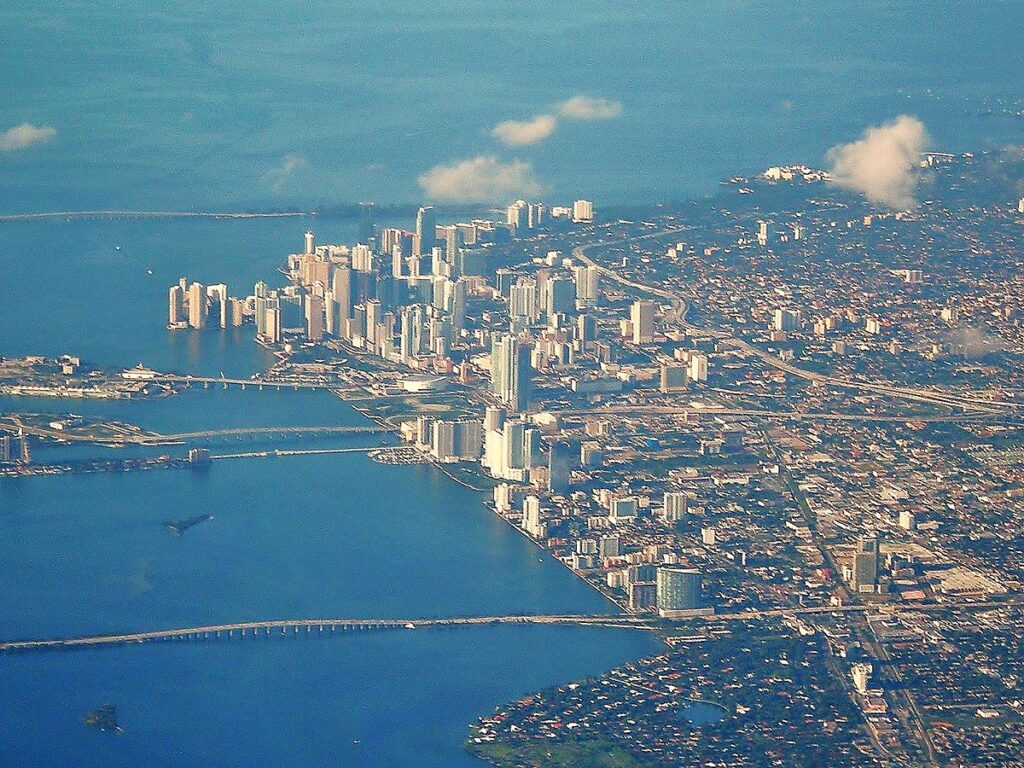
Moving to Miami, Florida: A Comprehensive Relocation Guide
Considering moving to Miami, Florida? This international metropolis offers vibrant culture, global business, and tropical lifestyle. As Florida’s second-largest city with approximately 455,000 residents in 2025 (metro 6.2 million+), Miami combines Latin American influence with beach access and world-class urban amenities.
Demographic Profile to Consider If Moving to Miami:
Miami’s 2025 population is approximately 455,000 within city limits, with the metro area exceeding 6.2 million residents. The median age is around 40 years, with incredibly diverse populations including Latin American majorities, international business professionals, young adults, and families. The population is approximately 70% Hispanic, 15% Black or African American, 12% White non-Hispanic. Miami features distinct neighborhoods from Brickell’s high-rise financial district to Little Havana’s Cuban culture to Wynwood’s arts district to Coconut Grove’s historic charm. The city is America’s most Latin American-influenced metropolis, with Spanish widely spoken and Caribbean/Latin cultures defining character. Miami attracts international residents, entrepreneurs, and those seeking global city energy. The cosmopolitan atmosphere creates a unique American experience. Find trusted local services for moving, living, and working in Miami.Miami Relocation Directory
Cost of Living to Consider If Moving to Miami:
Miami represents premium pricing with high housing costs. Median home values range from $500,000 to $750,000+ in 2025, with luxury areas like Brickell, Design District, and waterfront properties commanding millions. The median household income is approximately $50,000, creating affordability challenges. Rental properties average $2,500 to $4,000+ monthly depending on location. Florida’s lack of state income tax provides some relief. Overall cost of living is among America’s highest, particularly housing. Miami attracts wealthy international buyers, creating pricing pressure. The combination of limited space, international demand, and lifestyle appeal drives costs. Many service workers face affordability challenges. Neighborhoods vary dramatically in pricing from luxury districts to modest areas.
Economy and Job Market:
Miami’s economy is diverse and globally connected, centered on international trade, finance, tourism, real estate, and healthcare. The city serves as the Gateway to Latin America with banking, international business, and corporate headquarters. Port Miami is the world’s busiest cruise port and major cargo facility. Miami International Airport is a global aviation hub. Major employers include Baptist Health, Jackson Health System, Miami-Dade County, Norwegian Cruise Line, and numerous banks. The tourism and hospitality sectors employ thousands. Real estate and construction remain significant. Technology and startup sectors are growing in Wynwood and other districts. Professional services including law, accounting, and consulting thrive. The bilingual workforce and Latin American connections create unique opportunities. Typical industries include finance, trade, hospitality, healthcare, and real estate.
Education:
Miami-Dade County Public Schools serves Miami students, operating as one of America’s largest school districts. The city includes numerous schools with varied quality and magnet programs. Private schools throughout the area offer alternatives. Miami Dade College is one of America’s largest colleges providing associate degrees. The University of Miami is a prestigious private research university in Coral Gables. Florida International University serves over 50,000 students. Barry University and other institutions provide options. The large district serves incredibly diverse populations with English language learner programs. Educational quality varies dramatically by school, requiring research.
Recreation and Lifestyle:
Miami offers world-class beaches including South Beach, Crandon Park, and numerous coastal access points. The city features legendary nightlife with clubs, bars, and entertainment in South Beach, Brickell, and Wynwood. Art Basel Miami Beach and Design District attract global art enthusiasts. Wynwood Walls showcase street art. The city hosts professional sports including Miami Heat (NBA), Miami Dolphins (NFL), Inter Miami CF (MLS with Lionel Messi), and Miami Marlins (MLB). Bayside Marketplace and Lincoln Road provide shopping and dining. The cultural scene includes Pérez Art Museum Miami, Adrienne Arsht Center, and numerous venues. Boating and water sports thrive year-round. Little Havana celebrates Cuban culture. The tropical climate creates perpetual summer. The lifestyle emphasizes nightlife, beach culture, international cuisine, and cosmopolitan energy. The city never sleeps.
Healthcare and Services:
Miami residents access world-class healthcare through Jackson Health System, Baptist Health, Mount Sinai Medical Center, and University of Miami Health System. The region serves as a medical hub for Latin America with specialized care in all disciplines. Numerous hospitals and medical facilities operate throughout the metro. The healthcare infrastructure is extensive and internationally recognized.
Transportation:
Miami benefits from extensive infrastructure including Interstate 95, Interstate 395, and the Dolphin Expressway. Miami International Airport is a global hub. Miami-Dade Transit operates Metrorail, Metromover (free downtown), and extensive bus routes. Brightline high-speed rail connects to Fort Lauderdale, West Palm Beach, and Orlando. Traffic congestion is significant. Many urban areas offer walkability. Ride-sharing is popular. Typical commute times range 30-50 minutes. The city’s sprawl creates transportation challenges.
Conclusion:
Moving to Miami in 2025 offers international city living with Latin American culture, tropical beaches, and global business opportunities. The city’s combination of cosmopolitan energy, cultural diversity, year-round summer, and worldwide connections makes it ideal for international professionals, entrepreneurs, and those seeking America’s most globally-connected urban experience, where the Caribbean meets Manhattan.

